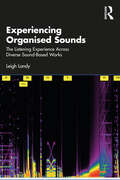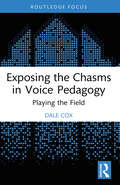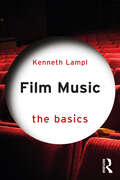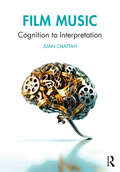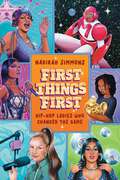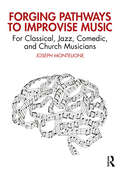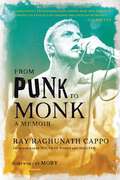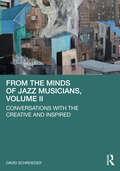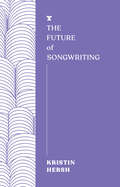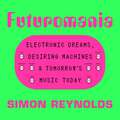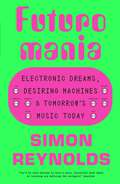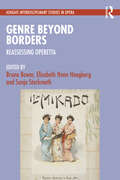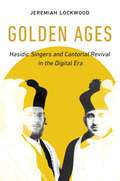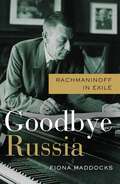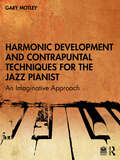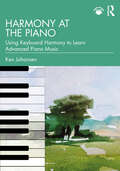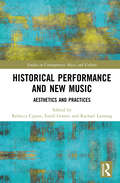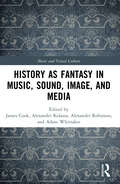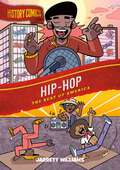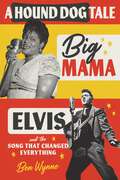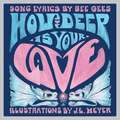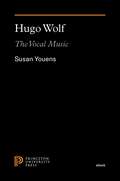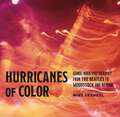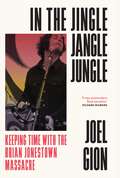- Table View
- List View
Experiencing Organised Sounds: The Listening Experience Across Diverse Sound-Based Works
by Leigh LandyExperiencing Organised Sounds investigates a wide horizon of sound-based works using a template consistently across its 16 studies. It has been written for both specialist and non-specialist readers aiming to address means of increasing appreciation and understanding related to the experience of sonic creativity (music involving any sounds, not just musical notes) across this repertoire, as well as to launch a discussion about how the reception of sonic creativity can be influenced by the circumstances of listening – in particular, regarding the qualitative difference between the in-situ as opposed to mediated experience. Although listening is the volume’s focus, complementary information from the musicians is offered to facilitate holistic work overviews. As the first composition presented was composed by a 15-year-old, the intention is to demonstrate that what might be considered a niche area of the contemporary arts is one in which both increased appreciation and participation could and should easily be achieved. The book’s work discussions are divided over three central chapters focused on fixed-medium compositions, performed and sound artworks. Experiencing Organised Sounds can be used as an undergraduate textbook, by experienced readers or those new to the area. All works discussed and related materials are available to readers online.
Exposing the Chasms in Voice Pedagogy: Playing the Field
by Dale CoxThis concise book critically examines the intersection of power, privilege, and classical music in higher education through an extensive study of the experiences, training, and background of teachers of musical theatre singing.Mapping the divides within the voice pedagogy field, it shows how despite the growth of non-classical programmes, the teaching of vocal music in the United States continues to be structurally dominated by Western classical music. Drawing on extensive fieldwork and observations of practicing instructors, the author argues that current voice pedagogy training’s classical-centred approach fails to prepare instructors to teach the range of vocal styles needed in the contemporary musical theatre profession. Combining a critical review of existing practices with proposals for change, this book sheds light on a key problem in voice pedagogy today.Based on field research and drawing on both Shulman’s signature pedagogies theory and Bourdieu’s concepts of habitus, capitals, practice, and field, this book will be useful for scholars, researchers, and practitioners of voice pedagogy, higher music education, performance education, cultural studies, music, musical theatre, and theatre studies.
Film Music: The Basics (The Basics)
by Kenneth LamplA comprehensive introduction to film music, this book provides a concise and illuminating summary of the process of film scoring, as well as a succinct overview of the rich history of contemporary film music. Written in a non-technical style, this book begins by presenting a brief history of film music from the last 30 years, covering topics ranging from blockbuster franchises to indie film scores. It explores film music from around the world, including Bollywood and European Avant-garde cinema, and film music in animation, like Disney-Pixar and Japanese anime. It then offers a guide to the language of film music analysis, the creative process behind composing film music, and the use of current technology. The book champions diversity in the industry, with case studies and interviews from a range of active film composers, including: Pinar Toprak (Captain Marvel, 2019), Kris Bowers (Bridgerton, 2020), Natalie Holt (Loki, 2021), and Rachel Portman (Emma, 1996), Complete with a glossary of key terms and further reading, this book is an invaluable resource for all those beginning to study film music, as well as lifelong film music buffs seeking to update their understanding of film music.
Film Music: Cognition to Interpretation
by Juan ChattahFilm Music: Cognition to Interpretation explores the dynamic counterpoint between a film’s soundtrack, its visuals and narrative, and the audience’s perception and construction of meaning. Adopting a holistic approach covering both the humanities and the sciences—blending cognitive psychology, musical analysis, behavioral neuroscience, semiotics, linguistics, and other related fields—the author examines the perceptual and cognitive processes that elicit musical meaning in film and breathe life into our cinematic experiences. A clear and engaging writing style distills complex concepts, theories, and analytical methodologies into explanations accessible to readers from diverse disciplinary backgrounds, making it an indispensable companion for scholars and students of music, film studies, and cognition. Across ten chapters, extensive appendices, and hundreds of film references, Film Music: Cognition to Interpretation offers a new mode of analysis, inviting readers to unlock a deeper understanding of the expressive power of film music.
First Things First: Hip-Hop Ladies Who Changed the Game
by Nadirah SimmonsThis enlightening book reframes the history of hip-hop—and this time, women are given credit for all their trailblazing achievements that have left an undeniable impact on music. FIRST THINGS FIRST, hip-hop is not just the music, and women have played a big role in shaping the way it looks today. FIRST THINGS FIRST takes readers on a journey through some notable firsts by women in hip-hop history and their importance. Factual firsts like Queen Latifah becoming the first rapper to get a star on the Hollywood Walk of Fame, Lauryn Hill making history as the first rapper to win the coveted Album of the Year Award at the GRAMMYs, April Walker being the first woman to dominate in the hip-hop fashion game, and Da Brat being the first solo woman rapper to have an album go platinum, and metaphorical firsts like Missy Elliott being the first woman rapper to go to the future. (Trust me, she really did.) There are chapters on music legends like Nicki Minaj, Lil&’ Kim and Mary J. Blige, tv and radio hosts like Big Lez and Angie Martinez, and so many more ladies I would name but I don&’t want to spoil the book! There are games, charts and some fire images, too. Altogether, FIRST THINGS FIRST is a celebration of the achievements of women in hip-hop who broke down barriers and broke the mold. So the next time someone doesn&’t have their facts straight on the ladies in hip-hop, you can hit them with &“first things first&”…
Forging Pathways to Improvise Music: For Classical, Jazz, Comedic, and Church Musicians
by Joseph MontelioneA step-by-step resource on forging one’s own pathway to improvise music, this book guides the musician through a clear and simple method that will easily translate to the reader’s genre of choice. Many musicians struggle with improvisation. Coincidentally, educators also find it challenging to integrate improvisation into curriculum. This book breaks down the barriers most performers and educators combat in the learning and teaching of improvisation, and is a helpful approach to demystify the complicated sphere of music improvisation. Divided into three sections, the first part of the book helps the reader develop an improvisatorial mindset to mentally conceive musical ideas, regardless of genre. The second portion then connects the improviser’s mindset to translating those ideas into a compelling musical performance in real time. The book’s final third assists the reader with discovering how to apply this method of improvisation to the nuanced liturgical, comedic, jazz, and classical styles. Forging Pathways to Improvise Music offers a practical introduction to improvisational methods essential for educators, students, and musicians of diverse educational backgrounds and musical genres.
Forging Pathways to Improvise Music: For Classical, Jazz, Comedic, and Church Musicians
by Joseph MontelioneA step-by-step resource on forging one’s own pathway to improvise music, this book guides the musician through a clear and simple method that will easily translate to the reader’s genre of choice. Many musicians struggle with improvisation. Coincidentally, educators also find it challenging to integrate improvisation into curriculum. This book breaks down the barriers most performers and educators combat in the learning and teaching of improvisation, and is a helpful approach to demystify the complicated sphere of music improvisation. Divided into three sections, the first part of the book helps the reader develop an improvisatorial mindset to mentally conceive musical ideas, regardless of genre. The second portion then connects the improviser’s mindset to translating those ideas into a compelling musical performance in real time. The book’s final third assists the reader with discovering how to apply this method of improvisation to the nuanced liturgical, comedic, jazz, and classical styles. Forging Pathways to Improvise Music offers a practical introduction to improvisational methods essential for educators, students, and musicians of diverse educational backgrounds and musical genres.
From Punk to Monk: A Memoir
by Ray CappoThe heartfelt memoir of Ray Raghunath Cappo, a legendary hardcore punk musician-turned-monk—and pioneer of the straight edge movement—told with warmth, candor, and humor.Ray Cappo was a hardcore punk singer and pioneer of the straight-edge movement living on the Lower East Side of New York City in the &’80s, where his band Youth of Today played to packed clubs and touched thousands of people across the globe. But despite the accolades from fans, the popularity of his records, and the positivity he&’d brought to the punk music scene, none of this success gave Ray joy. He felt stagnant, and he yearned for something more. This, along with his father&’s untimely death, led him to abruptly quit the band and buy a one-way ticket to India in pursuit of the answers to life&’s great mysteries. Living as a monk in the sacred city of Vrindavan and traveling across the country on a series of train trips, Ray embraced the rich, spiritual culture he discovered there. As his unusual adventure unfolded, he encountered extraordinary characters, witnessed deep acts of devotion, and experienced profound moments of divine connection, leading to a radical transformation that was ego-crushing and blissful all at once. Inspired to write music again, Ray returned to the US, where he and other monks founded Shelter, a band dedicated to spreading a message of faith, hope, and love. Told with warmth, candor, and humor, this heartfelt memoir chronicles Ray&’s emotional and spiritual journey from punk to monk and beyond.
From the Minds of Jazz Musicians, Volume II: Conversations with the Creative and Inspired
by David SchroederFrom the Minds of Jazz Musicians, Volume II is a follow-up to Volume I’s celebration of contemporary jazz artists who have toiled, struggled and succeeded in finding their creative space. Volume II was developed through transcribing and editing selected interviews with 29 jazz artists, conducted by the author since 2011, along with a historical essay on each artist. The interviews feature musicians from a broad range of musical styles and experiences, with their beginnings ranging from the 50s to the early 80s. Topics range from biographical life histories to descriptions of mentor relationships, revealing the important life lessons they learned along the way. With the goal to discover the person behind the persona, the author elicits conversations that speak of the creative process, mining the individualistic perspectives of seminal artists who witnessed history in the making. By comparing and contrasting each artist’s perspective to discover similarities in their career paths. these volumes are an important research tool for students and academics, offering direct information from leading figures in the jazz world.
The Future of Songwriting
by Kristin HershThrowing Muses frontwoman and critically acclaimed solo artist Kristin Hersh meditates on the future of her craft in this wry, existential and passionate addition to Melville House&’s new series, FUTURES.Over a long, hot Christmas in Australia, Throwing Muses frontwoman and critically acclaimed solo artist Kristin Hersh considers her future as a songwriter.Is it possible to create music and not show off about it? How can artists establish and refine a following without becoming part of the commercial problem? And just how many times is it healthy to watch It's A Wonderful Life in 3 weeks?In The Future of Songwriting, Hersh chooses to interrogate these questions through philosophical dialogue. From in-depth conversations with a comedian friend about the similarities between songs and jokes, via a fruitful visit to Sydney's 'bone museums', to a revelation from an acupuncturist in New Orleans, she delivers a fierce, funny and existential meditation on the art of the song – and its future.
Futuromania: Electronic Dreams, Desiring Machines and Tomorrow’s Music Today
by Simon ReynoldsSimon Reynolds's first book in eight years is a celebration of music that feels like a taste of tomorrow. Sounds that prefigure pop music's future - the vanguard genres and heroic innovators whose discoveries eventually get accepted by the wider mass audience. But it's also about the way music can stir anticipation for a thrillingly transformed world just around the corner: a future that might be utopian or dystopian, but at least will be radically changed and exhilaratingly other. Starting with an extraordinary chapter on Giorgio Moroder and Donna Summer, taking in illuminating profiles of Ryuichi Sakamoto, Boards of Canada, Burial, and Daft Punk, and arguing for Auto-Tune as the defining sound of 21st century pop, Futuromania shapes over two-dozen essays and interviews into a chronological narrative of machine-music from the 1970s to now. Reynolds explores the interface between pop music and science fiction's utopian dreams and nightmare visions, always emphasising the quirky human individuals abusing the technology as much as the era-defining advances in electronic hardware and digital software. A tapestry of the scenes and subcultures that have proliferated in that febrile, sexy and contested space where man meets machine, Futuromania is an enthused listening guide that will propel readers towards adventures in sound. There is a lifetime of electronic listening here.
Futuromania: Electronic Dreams, Desiring Machines and Tomorrow’s Music Today
by Simon ReynoldsSimon Reynolds's first book in eight years is a celebration of music that feels like a taste of tomorrow. Sounds that prefigure pop music's future - the vanguard genres and heroic innovators whose discoveries eventually get accepted by the wider mass audience. But it's also about the way music can stir anticipation for a thrillingly transformed world just around the corner: a future that might be utopian or dystopian, but at least will be radically changed and exhilaratingly other. Starting with an extraordinary chapter on Giorgio Moroder and Donna Summer, taking in illuminating profiles of Ryuichi Sakamoto, Boards of Canada, Burial, and Daft Punk, and arguing for Auto-Tune as the defining sound of 21st century pop, Futuromania shapes over two-dozen essays and interviews into a chronological narrative of machine-music from the 1970s to now. Reynolds explores the interface between pop music and science fiction's utopian dreams and nightmare visions, always emphasising the quirky human individuals abusing the technology as much as the era-defining advances in electronic hardware and digital software. A tapestry of the scenes and subcultures that have proliferated in that febrile, sexy and contested space where man meets machine, Futuromania is an enthused listening guide that will propel readers towards adventures in sound. There is a lifetime of electronic listening here.
Genre Beyond Borders: Reassessing Operetta (Ashgate Interdisciplinary Studies in Opera)
by Bruno Bower, Elisabeth Honn Hoegberg, and Sonja StarkmethThis book offers an innovative approach to understanding operetta, drawing attention to its malleability and resistance to boundaries. These shows have traversed (and continue to traverse) with ease the national borders which might superficially define them, or draw on features from many other genres without fundamentally changing in tone or approach. The chapters move from nineteenth-century London and Paris to twentieth-century North America, South America and Europe to present-day Australia. Some offer fresh understandings of familiar composers, such as Johann Strauss or Gilbert and Sullivan, while others examine works or composers that are less well-known. The chapter on Socialist operetta in Czechoslovakia in particular will almost certainly be a revelation to anyone from Western Europe or the US, where operetta is often understood to be a bourgeois phenomenon. As a summary of the current state of the field, this collection showcases the many possible pathways for future scholars who wish to explore it.
Golden Ages: Hasidic Singers and Cantorial Revival in the Digital Era (University of California Series in Jewish History and Cultures #3)
by Jeremiah LockwoodA free ebook version of this title is available through Luminos, University of California Press’s Open Access publishing program. Visit www.luminosoa.org to learn more.Golden Ages is an ethnographic study of young singers in the contemporary Brooklyn Hasidic community who base their aesthetic explorations of the culturally intimate space of prayer on the gramophone-era cantorial golden age. Jeremiah Lockwood proposes a view of their work as a nonconforming social practice that calls upon the sounds and structures of Jewish sacred musical heritage to disrupt the aesthetics and power hierarchies of their conservative community, defying institutional authority and pushing at normative boundaries of sacred and secular. Beyond its role as a desirable art form, golden age cantorial music offers aspiring Hasidic singers a form of Jewish cultural productivity in which artistic excellence, maverick outsider status, and sacred authority are aligned.
Goodbye Russia: Rachmaninoff in Exile
by Fiona MaddocksThe moving story of Rachmaninoff's years in exile and the composition of his last great work, set against a cataclysmic backdrop of two world wars and personal tragedy.In 1940, Sergei Rachmaninoff, living in exile in America, broke his creative silence and composed a swan song to his Russian homeland—his iconic &“Symphonic Dances.&” What happened in those final haunted years and how did he come to write his farewell masterpiece? Rachmaninoff left Petrograd (now St. Petersburg) in 1917 during the throes of the Russian Revolution. He was forty-four years old, at the peak of his powers as composer-conductor-performer, moving in elite Tsarist circles, as well as running the family estate, his refuge and solace. He had already written the music which, today, has made him one of the most popular composers of all time: the second and third Piano Concertos and two symphonies. The story of his years in exile in America and Switzerland has only been told in passing. Reeling from the trauma of a life in upheaval, he wrote almost no music and quickly had to reinvent himself as a fêted virtuoso pianist, building up untold wealth and meeting the stars—from Walt Disney and Charlie Chaplin to his Russian contemporaries and polar opposites, Prokofiev and Stravinsky. Yet the melancholy of leaving his homeland never lifted. Using a wide range of sources, including important newly translated texts, Fiona Maddocks&’s immensely readable book conjures impressions of this enigmatic figure, his friends and the world he encountered. It explores his life as an emigré artist and how he clung to an Old Russia which no longer existed. That forging of past and present meets in his Symphonic Dances (1940), his last composition, written on Long Island shortly before his death in Beverly Hills, surrounded by a close-knit circle of exiles. Goodbye Russia is a moving and prismatic look at Rachmaninoff and his iconic final work.
Harmonic Development and Contrapuntal Techniques for the Jazz Pianist: An Imaginative Approach
by Gary MotleyHarmonic Development and Contrapuntal Techniques for the Jazz Pianist serves as a guide for harmonic expansion and development for jazz piano, offering pianists both a rationale and methods to improve contrapuntal hand techniques. The text focuses on the relationship between theory and execution and both of those components’ usefulness in creating a jazz sound at the piano. This kinaesthetic method provides the learner with a systematic approach to harmonic movement, revealing options that may not have been otherwise apparent. This method will allow pianists to add depth and dimension to their chord voicings in the same way that vocalists and wind instrumentalists give character and shape to the notes they create. Key features include musical examples ranging from singular chord construction to sophisticated harmonic progressions and song application. Performance exercises are provided throughout the text. Learners and instructors are encouraged to create their own exercises. Related ancillaries at harmoniccounterpoint.com include: Musical examples Audio tracks Performance exercises Written assignments Intended for the learner who is reasonably familiar with essential jazz harmony, this textbook will be both a significant resource for the advanced player and a fundamental component for the learner in a structured academic musical setting.
Harmony at the Piano: Using Keyboard Harmony to Learn Advanced Piano Music
by Ken JohansenHarmony at the Piano adapts the traditional study of keyboard harmony to the practical needs of modern piano students, using innovative exercises to help students practice their repertoire more deliberately, consciously, and creatively. The author introduces the essential elements of harmony through extensive examples from real piano music. Rooted in the understanding that the language of tonal harmony is best assimilated at the keyboard, this textbook: Gives students effective practice methods for learning repertoire, including techniques for memorizing music in a deliberate, analytical way. Connects harmony to musical expression, enabling students to make interpretive decisions based on their understanding of harmony. Contains extensive practice drills in each chapter, including chord progressions, figured bass, melody harmonization, reduction techniques, transposition, repertoire study, and more. Designed to support a full college or conservatory course in keyboard harmony, this book clearly connects the study of harmony to practical musicianship and keyboard skills, providing an essential resource for all instructors and students of advanced piano music. Extensive online resources complement this textbook, including suggested realizations of the figured bass exercises, the original scores of the melody harmonization and fill-in-the-blank exercises, as well as additional exercises and examples.
Historical Performance and New Music: Aesthetics and Practices
by Rebecca Cypess, Estelí Gomez, and Rachael LansangThe worlds of new music and historically informed performance might seem quite distant from one another. Yet, upon closer consideration, clear points of convergence emerge. Not only do many contemporary performers move easily between these two worlds, but they often do so using a shared ethos of flexibility, improvisation, curiosity, and collaboration—collaboration with composers past and present, with other performers, and with audiences. Bringing together expert scholars and performers considering a wide range of issues and case studies, Historical Performance and New Music—the first book of its kind—addresses the synergies in aesthetics and practices in historical performance and new music. The essays treat matters including technologies and media such as laptops, printing presses, and graphic notation; new music written for period instruments from natural horns to the clavichord; personalities such as the pioneering singer Cathy Berberian; the musically “omnivorous” ensembles A Far Cry and Roomful of Teeth; and composers Luciano Berio, David Lang, Molly Herron, Caroline Shaw, and many others. Historical Performance and New Music presents pathbreaking ideas in an accessible style that speaks to performers, composers, scholars, and music lovers alike. Richly documented and diverse in its methods and subject matter, this book will open new conversations about contemporary musical life.
History as Fantasy in Music, Sound, Image, and Media (Music and Visual Culture)
by James Cook, Alexander Kolassa, Alexander Robinson, and Adam WhittakerExploring how music is used to portray the past in a variety of media, this book probes the relationship between history and fantasy in the imagination of the musical past. The volume brings together essays from multidisciplinary perspectives, addressing the use of music to convey a sense of the past in a wide range of multimedia contexts, including television, documentaries, opera, musical theatre, contemporary and historical film, videogames, and virtual reality. With a focus on early music and medievalism, the contributors theorise the role of music and sound in constructing ideas of the past. In three interrelated sections, the chapters problematise notions of historical authenticity on the stage and screen; theorise the future of musical histories in immersive and virtual media; and explore sound’s role in more fantastical appropriations of history in television and videogames. Together, they poseprovocative questions regarding our perceptions of ‘early’ music and the sensory experience of distant history. Offering new ways to understand the past at the crossroads of musical and visual culture, this collection is relevant to researchers across music, media, and historical and cultural studies.
History Comics: The Beat of America (History Comics)
by Jarrett WilliamsMUSICAL REVOLUTION SWEEPS NATION AND BEYONDHow did a bunch of young people from the inner city create a genre of music that became a global phenomenon? From its humble origins at house parties in the Bronx, where DJs mixed old records to create new sounds, charismatic MCs let their clever lyrics flow, and B-boys and B-girls pioneered inventive dance moves, hip-hop quickly became a musical and cultural revolution. Hip-Hop: The Beat of AmericaMeet Aaliyah, a hip-hop superfan who is about to get a lesson in all things “old school” courtesy of her dad, who grew up in the 1970s when rap music first hit the scene. The pair take a day trip to the Bronx where Aaliyah discovers the many unsung heroes who helped create the foundations of the hip-hop we all enjoy today. So get ready to drop the beat, bust a move, and get down with some fresh rap knowledge!Perfect for readers of Can't Stop, Won't Stop and Nathan Hale's Hazardous tales.
A Hound Dog Tale: Big Mama, Elvis, and the Song That Changed Everything
by Ben WynneThe release of the song “Hound Dog” in 1953 marked a turning point in American popular culture, and throughout its history, the hit ballad bridged divides of race, gender, and generational conflict. Ben Wynne’s A Hound Dog Tale discusses the stars who made this rock ’n’ roll standard famous, from Willie Mae “Big Mama” Thornton to Elvis Presley, along with an eclectic cast of characters, including singers, songwriters, musicians, record producers and managers, famous television hosts, several lawyers, and even a gangster or two.Wynne’s examination of this American classic reveals how “Hound Dog” reflected the values and issues of 1950s American society, and sheds light on the lesser-known elements of the song’s creation and legacy. A Hound Dog Tale will capture the imagination of anyone who has ever tapped a foot to the growl of a blues riff or the bark of a rock ’n’ roll guitar.
How Deep Is Your Love: A Children's Picture Book
by Bee GeesA majestic picture book based on the Bee Gees's classic love song "How deep is your love? I really mean to learn 'Cause we're living in a world of fools Breaking us down When they all should let us be We belong to you and me . . ." How Deep Is Your Love is a fantastical picture book based on one of the Bee Gees's biggest hits. The song topped the Billboard Hot 100 chart, remaining in the top ten for seventeen weeks, and won the band's first of eight GRAMMY awards. With lyrics by the Bee Gees and illustrations by J.L. Meyer, the picture book tells the tale of two bunny mermaids who meet on a rock and descend into the water together. As the bunnies escape traps, skirt around nets and hooks, and protect each other in this thrilling adventure, they realize how deep their love is. Meyer's imaginative story compliments the hit song perfectly and will delight children and adults alike.
Hugo Wolf: The Vocal Music
by Susan YouensA groundbreaking look at one of the great song composers of the late Romantic periodIn the virtual cottage industry of works on fin de siècle Vienna, Hugo Wolf (1860–1903) has been somewhat neglected, perhaps because he was the master of a small genre—the late Romantic lied—and never truly made his mark in the larger forms that command greater public attention. But in the realm of song, he is among the greatest inheritors of Schubert and Schumann, one who was both a traditionalist and a modernist. When the Viennese critic Eduard Hanslick disapprovingly dubbed Wolf &“the Richard Wagner of the lied,&” he was paying oblique homage to Wolf&’s genius as a song composer in the most modern manner.In this book, Susan Youens examines five aspects of Wolf&’s compositional art, each exemplifying a different synthesis of traditionalism and modernity and spanning his entire, tragically brief creative life, from his first efforts to his lapse into insanity in 1897. She discusses Wolf&’s youthful imitations of Schumann, his genius for comic songs of a kind unlike any of his predecessors, his part in the ballad revival of the late nineteenth century, Wolf in relation to his contemporaries, and his pursuit of operatic fame. Youens looks as closely at the poetic texts as she does the music and includes numerous previously unpublished sketches and fragments, examples from songs now long out of print and difficult to obtain, and citations from Wolf&’s vivid letters and other sources of the period.
Hurricanes of Color: Iconic Rock Photography from the Beatles to Woodstock and Beyond (American Music History)
by Mike FrankelIn 1964, fifteen-year-old Mike Frankel found himself among professional photojournalists covering a Beatles concert during the band’s first tour in the United States. A few years later, he was a regular photographer at the Fillmore East, a storied venue in classic rock. And in 1969, he was onstage at Woodstock, documenting one of the most important events in American music history.Featuring Frankel’s stunning photographs of nearly every major rock figure from the 1960s and ’70s—including Led Zeppelin, Pink Floyd, the Rolling Stones, Janis Joplin, and the Grateful Dead—as well as many unpublished images of the Beatles, Hurricanes of Color chronicles an extraordinary moment. Frankel, who was for a time a personal photographer for Jefferson Airplane and Hot Tuna, developed an innovative style—one that layered images with multiple exposures to capture the spirit of the music of the era and the experience of listening to the bands live.A must-have for fans of classic rock, this is a spectacular and profound collection of photography that complements the music of the world’s biggest performers.
In the Jingle Jangle Jungle: Keeping Time with the Brian Jonestown Massacre
by Joel GionThe Brian Jonestown Massacre are one of the great contemporary cult American rock and roll bands. At the peak of their anarchic reign in the San Francisco underground of the mid '90s their psychedelic output was almost as prodigious and impressive as their narcotic intake. Immortalised in one of the most unforgettable rock and roll documentaries of all time, DIG! alongside their friends/rivals/nemeses, The Dandy Warhol's, in their early years when the US were obsessed with grunge, the BJM felt like a '60s anachronism. But with albums like Their Satanic Majesties Second Request and Thank God for Mental Illness, and incendiary, often chaotic, live shows, they burnished their legend as true believers and custodians of the original west coast flame; a privilege and responsibility which continues to this day when the band have a bigger and more dedicated audience than ever.Joel Gion's memoir tells the story of the first ten years of the band from the Duke Seat. A righteous account of the hazards and pleasures of life on and off the road, In the Jingle Jangle Jungle takes use behind the scenes of the supposed behind the scenes film that cemented the band's legend. Funny as hell, shot through with the innocence and wonder of a 'percussionist' whose true role is that of the band's 'spirit animal', In the Jingle Jangle Jungle is destined to take its place alongside cult classics in the pantheon of rock and roll literature like Playing the Bass with Three Left Hands, Head On, and 45 by Bill Drummond. It will also feature a foreword by Anton Newcombe, fellow member and founder of The Brian Jonestown Massacre.
